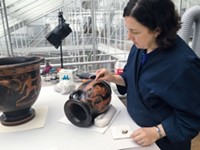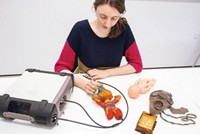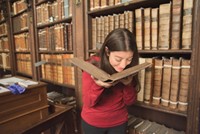Advertisement
Grab your lab coat. Let's get started
Welcome!
Welcome!
Create an account below to get 6 C&EN articles per month, receive newsletters and more - all free.
It seems this is your first time logging in online. Please enter the following information to continue.
As an ACS member you automatically get access to this site. All we need is few more details to create your reading experience.
Not you? Sign in with a different account.
Not you? Sign in with a different account.
ERROR 1
ERROR 1
ERROR 2
ERROR 2
ERROR 2
ERROR 2
ERROR 2
Password and Confirm password must match.
If you have an ACS member number, please enter it here so we can link this account to your membership. (optional)
ERROR 2
ACS values your privacy. By submitting your information, you are gaining access to C&EN and subscribing to our weekly newsletter. We use the information you provide to make your reading experience better, and we will never sell your data to third party members.
Analytical Chemistry
North Carolina State University Receives Dye Library Donation From Eastman Chemical
Colorful and historic collection will become publicly available online, could aid art conservation and forensic science
by Carmen Drahl
June 2, 2014
| A version of this story appeared in
Volume 92, Issue 22
Demands for colorful, cheap, and diverse dyes drove the transformation of chemistry into a modern science. To some, it may seem like dyestuffs are the stuff of times past. A dye collection recently donated to a university, however, might show that these compounds still hold the key to some cutting-edge chemistry problems.
Eastman Chemical has donated a dye collection spanning 50 years of the company’s research, beginning in the 1940s, to North Carolina State University. The library includes vials filled with vibrant powders, each meticulously hand-labeled; coordinating envelopes stuffed with dyed fabric swatches and testing data; and post-World War II intelligence reports on the German dye industry. The collection is named for the late Max A. Weaver, a longtime Eastman research leader who made the library his life’s work.
“This dye collection is a research treasure trove,” says David Hinks, director of the university’s Forensic Sciences Institute. NC State has agreed to build a digital database of the approximately 98,000 compounds. All of the structures, previously trade secrets, will become available to the public on the Royal Society of Chemistry’s ChemSpider database.
The university’s archive of compound spectra will be free to the forensic chemistry community so that they can be used for textile dye analysis and identification. Spectra and compound samples will be available for a fee to researchers in other fields.
The decision to donate the Weaver dye collection didn’t happen overnight, explains J. Stewart Witzeman, who heads the Eastman Innovation Center lab at NC State, a hub for industry-university joint research. The collection had been used only for internal purposes. The company thought about partnerships and other collaborations, “but there was never a well-articulated vision,” Witzeman says.
“If we were ever going to donate, we knew we had to do it soon,” Witzeman adds, “while people would still be alive to supplement the physical history with oral history.”
A chance lunch encounter between Witzeman and Hinks finally got the ball rolling. The donation is not part of the $10 million, six-year collaboration between the company and the university.
Forensic analytical chemist John V. Goodpaster, who studies dyed fibers at Indiana University-Purdue University Indianapolis, thinks the collection likely contains some but not all dyes in current use, so it might be of more help in solving cold cases than present-day crimes.
Most of the dyes in the collection were never commercialized; however, it’s the totality of the spectral data that is useful. When determining that a compound “matches” the dye from a fiber at a crime scene, Hinks says, forensic chemists would like to be able to associate an error rate with that identification. “If we can obtain spectra for nearly 100,000 dyes, then we can start to bring some statistics into the courtroom,” he says.
Because many of the dyes in the collection have related structures, Hinks adds, it might be possible to use them to identify impurity profiles in modern or classic colorants. Forensic chemists often use such profiles to trace a compound back to its manufacturer, he explains.
Having related compounds is also handy for developing new analytical methods for dye identification, says John Allison, who studies pen inks and other dyes at the College of New Jersey. “When you’re trying to get as much evidence as you can from a few fibers, you want a sensitive, precise method.”
Analytical chemists who’ll be working on spectroscopic methods with these dyes “will be in a very good position,” Allison says.
Meanwhile, Gregory D. Smith, a senior conservation scientist at the Indianapolis Museum of Art, is eager for the database’s debut. “A large dye library like this would be a godsend to cultural heritage chemists,” he says.
Smith and his colleagues use myriad techniques including Raman spectroscopy and mass spectrometry to characterize dyes in paintings, writing inks, photographs, and textiles. “Since we are dealing with materials that span antiquity to last week,” Smith says, “we need a very complete set of reference data.”
“A gift like the Eastman dye collection, if easily accessible and analyzed by a range of techniques, could alleviate one of our most frustrating situations in the lab—having great data that we can’t interpret.”






Join the conversation
Contact the reporter
Submit a Letter to the Editor for publication
Engage with us on Twitter